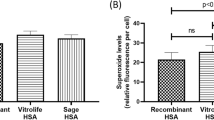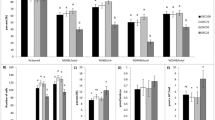Abstract
Purpose
To determine the composition of commercially available protein supplements for embryo culture media and test if differences in protein supplement composition are biologically relevant in a murine model.
Methods
Amino acid, organic acid, ion and metal content were determined for 6 protein supplements: recombinant human albumin (AlbIX), human serum albumin (HSA and Buminate), and three complex protein supplements (SSS, SPS, LGPS). To determine if differences in the composition of these supplements are biologically relevant, mouse one-cell embryos were collected and cultured for 120 hours in each protein supplement in Global media at 5 and 20 % oxygen in an EmbryoScope time-lapse incubator. The compositions of six protein supplements were analyzed for concentrations of 39 individual amino acids, organic acids, ions and elements. Blastocyst development and cell cycle timings were calculated at 96-hours of culture and the experiments were repeated in triplicate. Blastocyst gene expression was analyzed.
Results
Recombinant albumin had the fewest undefined components , the lowest concentration of elements detected, and resulted in high blastocyst development in both 5 and 20 % oxygen. Buminate, LGPS and SPS had high levels of transition metals whereas SSS had high concentrations of amino acids. Pre-compaction mouse embryo development was delayed relative to embryos in AlbIX for all supplements and blastocyst formation was reduced in Buminate, SPS and SSS.
Conclusions
The composition of protein supplements are variable, consisting of previously undescribed components. High concentrations of pro-oxidant transition metals were most notable. Blastocyst development was protein dependent and showed an interaction with oxygen concentration and pro-oxidant supplements.

Similar content being viewed by others
Explore related subjects
Discover the latest articles and news from researchers in related subjects, suggested using machine learning.References
Kane MT. Variability in different lots of commercial bovine serum albumin affects cell multiplication and hatching of rabbit blastocysts in culture. J Reprod Fertil. 1983;69:555–8.
McKiernan SH, Bavister BD. Different lots of bovine serum albumin inhibit or stimulate in vitro development of hamster embryos. In Vitro Cell Dev Biol. 1992;28A:154–6.
Meintjes M. Media composition: macromolecules and embryo growth. Methods Mol Biol. 2012;912:107–27.
Leonard PH, Charlesworth MC, Benson L, Walker DL, Fredrickson JR, Morbeck DE. Variability in protein quality used for embryo culture: embryotoxicity of the stabilizer octanoic acid. Fertil Steril. 2013;100:544–9.
Yu MW, Finlayson JS. Quantitative determination of the stabilizers octanoic acid and N-acetyl-DL-tryptophan in human albumin products. J Pharm Sci. 1984;73:82–6.
Bavister BD. Culture of preimplantation embryos: facts and artifacts. Hum Reprod Update. 1995;1:91–148.
Blake D, Svalander P, Jin M, Silversand C, Hamberger L. Protein supplementation of human IVF culture media. J Assist Reprod Genet. 2002;19:137–43.
Batt PA, Gardner DK, Cameron AW. Oxygen concentration and protein source affect the development of preimplantation goat embryos in vitro. Reprod Fertil Dev. 1991;3:601–7.
Caro CM, Trounson A. The effect of protein on preimplantation mouse embryo development in vitro. J In Vitro Fert Embryo Transf. 1984;1:183–7.
Leveille MC, Carnegie J, Tanphaichitr N. Effects of human sera and human serum albumin on mouse embryo culture. J Assist Reprod Genet. 1992;9:45–52.
Menezo Y, Testart J, Perrone D. Serum is not necessary in human in vitro fertilization, early embryo culture, and transfer. Fertil Steril. 1984;42:750–5.
Adler A, Reing AM, Bedford JM, Alikani M, Cohen J. Plasmanate as a medium supplement for in vitro fertilization. J Assist Reprod Genet. 1993;10:67–71.
Weathersbee PS, Pool TB, Ord T. Synthetic serum substitute (SSS): a globulin-enriched protein supplement for human embryo culture. J Assist Reprod Genet. 1995;12:354–60.
Meintjes M, Chantilis SJ, Ward DC, Douglas JD, Rodriguez AJ, Guerami AR, et al. A randomized controlled study of human serum albumin and serum substitute supplement as protein supplements for IVF culture and the effect on live birth rates. Hum Reprod. 2009;24:782–9.
Bungum M, Humaidan P, Bungum L. Recombinant human albumin as protein source in culture media used for IVF: a prospective randomized study. Reprod Biomed Online. 2002;4:233–6.
Otsuki J, Nagai Y, Matsuyama Y, Terada T, Era S. The redox state of recombinant human serum albumin and its optimal concentration for mouse embryo culture. Syst Biol Reprod Med. 2013;59:48–52.
Paczkowski M, Yuan Y, Fleming-Waddell J, Bidwell CA, Spurlock D, Krisher RL. Alterations in the transcriptome of porcine oocytes derived from prepubertal and cyclic females is associated with developmental potential. J Anim Sci. 2011;89:3561–71.
Paczkowski M, Silva E, Schoolcraft WB, Krisher RL. Comparative importance of fatty acid beta-oxidation to nuclear maturation, gene expression, and glucose metabolism in mouse, bovine, and porcine cumulus oocyte complexes. Biol Reprod. 2013;88:111.
Rozen S, Skaletsky H. Primer3 on the WWW for general users and for biologist programmers. Methods Mol Biol. 2000;132:365–86.
Pfaffl MW, Horgan GW, Dempfle L. Relative expression software tool (REST) for group-wise comparison and statistical analysis of relative expression results in real-time PCR. Nucleic Acids Res. 2002;30:e36.
Yuan Y, Ida JM, Paczkowski M, Krisher RL. Identification of developmental competence-related genes in mature porcine oocytes. Mol Reprod Dev. 2011;78:565–75.
Silva E, Paczkowski M, Krisher RL. The effect of leptin on maturing porcine oocytes is dependent on glucose concentration. Mol Reprod Dev. 2012;79:296–307.
Pool TB, Martin JE. High continuing pregnancy rates after in vitro fertilization-embryo transfer using medium supplemented with a plasma protein fraction containing alpha- and beta-globulins. Fertil Steril. 1994;61:714–9.
Kaspar H, Dettmer K, Gronwald W, Oefner PJ. Automated GC-MS analysis of free amino acids in biological fluids. J Chromatogr B Analyt Technol Biomed Life Sci. 2008;870:222–32.
Morbeck DE, Krisher RL, Herrick JR, Baumann NA, Matern D, Moyer T. Composition of commercial media used for human embryo culture. Fertil Steril. 2014;102:759–66 e9.
Wolff HS, Fredrickson JR, Walker DL, Morbeck DE. Advances in quality control: mouse embryo morphokinetics are sensitive markers of in vitro stress. Hum Reprod. 2013;28:1776–82.
Meuter A, Rogmann LM, Winterhoff BJ, Tchkonia T, Kirkland JL, Morbeck DE. Markers of cellular senescence are elevated in murine blastocysts cultured in vitro: molecular consequences of culture in atmospheric oxygen. J Assist Reprod Genet. 2014 epub.
Kryukov GV, Castellano S, Novoselov SV, Lobanov AV, Zehtab O, Guigo R, et al. Characterization of mammalian selenoproteomes. Science. 2003;300:1439–43.
Halliwell B. The wanderings of a free radical. Free Radic Biol Med. 2009;46:531–42.
Halliwell B. Cell culture, oxidative stress, and antioxidants: avoiding pitfalls. Biomed J. 2014;37:99–105.
Fraga CG. Relevance, essentiality and toxicity of trace elements in human health. Mol Aspects Med. 2005;26:235–44.
Bal W, Kasprzak KS. Induction of oxidative DNA damage by carcinogenic metals. Toxicol Lett. 2002;127:55–62.
Valko M, Morris H, Cronin MT. Metals, toxicity and oxidative stress. Curr Med Chem. 2005;12:1161–208.
Quinlan GJ, Coudray C, Hubbard A, Gutteridge JM. Vanadium and copper in clinical solutions of albumin and their potential to damage protein structure. J Pharm Sci. 1992;81:611–4.
Balla J, Vercellotti GM, Jeney V, Yachie A, Varga Z, Jacob HS, et al. Heme, heme oxygenase, and ferritin: how the vascular endothelium survives (and dies) in an iron-rich environment. Antioxid Redox Signal. 2007;9:2119–37.
Breuer W, Shvartsman M, Cabantchik ZI. Intracellular labile iron. Int J Biochem Cell Biol. 2008;40:350–4.
Halliwell B, Whiteman M. Measuring reactive species and oxidative damage in vivo and in cell culture: how should you do it and what do the results mean? Br J Pharmacol. 2004;142:231–55.
Halliwell B. Oxidative stress in cell culture: an under-appreciated problem? FEBS Lett. 2003;540:3–6.
Combelles CM, Hennet ML. Media composition: antioxidants/chelators and cellular function. Methods Mol Biol. 2012;912:129–59.
Roche M, Rondeau P, Singh NR, Tarnus E, Bourdon E. The antioxidant properties of serum albumin. FEBS Lett. 2008;582:1783–7.
Rosenbluth EM, Shelton DN, Wells LM, Sparks AE, Van Voorhis BJ. Human embryos secrete microRNAs into culture media-a potential biomarker for implantation. Fertil Steril. 2014;101:1493–500.
Menezo Y, Khatchadourian C. Peptides bound to albumin. Life Sci. 1986;39:1751–3.
Akopian V, Andrews PW, Beil S, Benvenisty N, Brehm J, Christie M, et al. Comparison of defined culture systems for feeder cell free propagation of human embryonic stem cells. In Vitro Cell Dev Biol Anim. 2010;46:247–58.
Chen G, Gulbranson DR, Hou Z, Bolin JM, Ruotti V, Probasco MD, et al. Chemically defined conditions for human iPSC derivation and culture. Nat Methods. 2011;8:424–9.
Garcia-Gonzalo FR, Izpisua Belmonte JC. Albumin-associated lipids regulate human embryonic stem cell self-renewal. PLoS One. 2008;3:e1384.
Skottman H, Hovatta O. Culture conditions for human embryonic stem cells. Reproduction. 2006;132:691–8.
Author information
Authors and Affiliations
Corresponding author
Additional information
Capsule
Protein supplements for IVF and embryo culture are highly heterogeneous and poorly defined. Some components of supplements adversely affect mouse embryo development and these effects are dependent on oxygen concentration used for culture.
Electronic supplementary material
Below is the link to the electronic supplementary material.
ESM 1
(DOC 38 kb)
ESM 2
(DOC 39 kb)
ESM 3
(DOC 34 kb)
ESM 4
(DOC 34 kb)
ESM 5
(DOC 33 kb)
ESM 6
(DOC 35 kb)
ESM 7
(DOC 35 kb)
Supplemental Figure 1
Specific cell division timings (hours; mean±se) from the 2-cell stage to 3-, 4-, 5- and 8 cells for embryos cultured with different protein supplements. Time to the 3-cell stage relative to AlbIX was longer for SPS (p<0.01) and Buminate and SSS (p<0.001). Time to 8-cell was delayed relative to AlbIX for Buminate, SSS, SPS and LGPS (p<0.01). (PPT 201 kb)
Supplemental Figure 2
Gene expression analyses, relative to 18s rRNA, for hatching mouse blastocysts cultured in 5 mg/mL AlbIX,10% Buminate, 5 mg/mL HSA, 10% LGPS, 10% SPS, or 10% SSS at 5% O2 compared to 20% O2. Positive fold changes indicate an increase in transcript abundance in embryos cultured at 20% O2 as compared to 5% O2, whereas a negative fold change indicates a decrease in transcript abundance in embryos cultured at 20% O2 as compared to 5% O2. *, P < 0.05; ‡, P < 0.1. (DOC 190 kb)
Rights and permissions
About this article
Cite this article
Morbeck, D.E., Paczkowski, M., Fredrickson, J.R. et al. Composition of protein supplements used for human embryo culture. J Assist Reprod Genet 31, 1703–1711 (2014). https://doi.org/10.1007/s10815-014-0349-2
Received:
Accepted:
Published:
Issue Date:
DOI: https://doi.org/10.1007/s10815-014-0349-2




